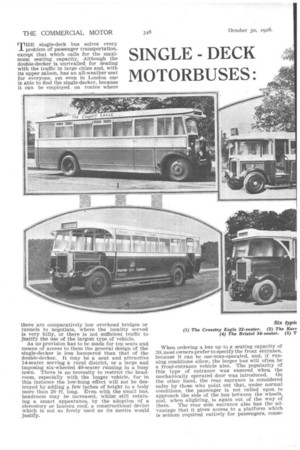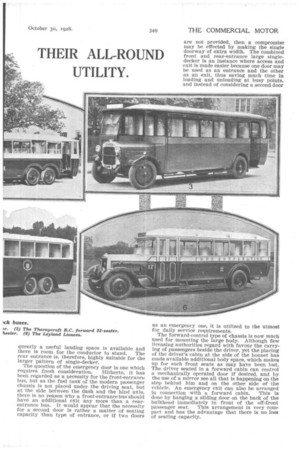SINGLE DECK
Page 28

Page 29

If you've noticed an error in this article please click here to report it so we can fix it.
THEIR ALL-ROUND
MOTORBUSES:
UTILITY.
THE single-deck bus solves every problem of passenger transportation, except that which calls for the maximum seating capacity. Although the double-decker is unrivalled for dealing with the traffic in large cities and, with its upper saloon, has an all-weather seat for everyone, yet even in London one is able to find the single-decker, because It can be employed , on routes where there are comparatively low overhead bridges or tunnels to negotiate, where the locality served is very hilly, or there is not sufficient traffic to justify the use of the largest type of vehicle. As no provision has to be made for top seats and means of access to them the general design of the single-decker is less hampered than that of the double-decker. It may be a neat and attractive 14-seater serving a rural district, or a large and imposing six-wheeled 40-seater running in a busy town. There is no necessity to restrict the headroom, especially with the longer vehicle, for in this instance the low-hung effect will not be destroyed by adding a few inches of height to a body more than 20 ft. long. Even with the small bus, headroom may be increased, whilst still retaining a smart appearance, by the adoption of a clerestory or lantern roof, a constructional device which is not So freely used as its merits would justify. When ordering a bus up to a seating capacity of 20, most owners prefer to specify the front entrance, because it can be one-man-operated, and, if running conditions allow, the larger bus will often be a front-entrance vehicle also. The popularity of this type of entrance was ensured when the mechanically operated door was introduced. On the other hand, the rear entrance is considered safer by those who point out that, under normal conditions, the passenger is not called upon to approach the side of the bus between the wheels, and, when alighting, is again out of the way of them. The rear side entrance also has the advantage that it gives access to a platform which is seldom required entirely for passengers, cease quently a useful landing space is available and there is room for the conductor to stand. The rear entrance is, therefore, highly suitable for the larger pattern of single-decker. The question of the emergency door is one which requires fresh consideration. Hitherto, it has been regarded as a necessity for the front-entrance bus, but as the fuel tank of the modern passenger chassis is not placed under the driving seat, but at the side between the dash and the hind axle, there is no reason why a front-entrance bus should have an additional exit any more than a rearentrance bus. It would appear that the necessity for a second door is rather a matter of seating capacity than type of entrance, or if two doors are not provided, then a compromise may be effected by making the single doorway of extra width. The combined front and rear-entrance large singledecker is an instance where access and exit is made easier because one door may be used as an entrance and the other as an exit, thus saving much time in loading and unloading at busy points, and instead of considering a second door as an emergency one, it is utilized to the utmost for daily service requirements.
The forward-control type of chassis is now much used for mounting the large body. Although few licensing authorities regard with favour the carrying of passengers beside the driver, yet the placing of the driver's cabin at the side of the bonnet has made available additional body space, which makes up for such front seats as may ha'Ve been lost. The driver seated in a forward cabin can control a mechanically operated door if desired, and by the use of a mirror see all that is happening on the step behind him and on the other side of the vehicle. An emergency exit can also be arranged In connection with a forward cabin. This is done by hanging a sliding door on the back of the bulkhead immediately in front of the off-front passenger seat. This arrangement is very compact and has the advantage that there is no loss of seating capacity.


















































